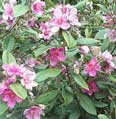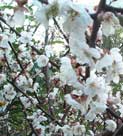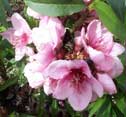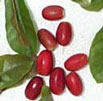May Newsletter, 2001
They're too beautiful to be fruit trees…There are many fruit trees that rival the most popular of ornamentals for decorative foliage, flowers and hardiness.

Ceylon Hill Gooseberrry

Mume Apricot

Dwarf Peach
|
|
|
|
Fruit tree enthusiasts will tell you time and time again that the taste of sun-ripened freshly picked fruit is more than enough reason to grow them - even in the smallest of back yards. More reasons are due to the beauty they offer the landscape, their practicality and the abundant rewards they give freely for your trouble. Fruit trees vary so much in size and appearance that they can serve many functions. A hedge of Lemon scented myrtle, Coffee or Ceylon hill cherry that will rival most of their competitors for beauty. Evergreen fruiting trees and shrubs from the lillypilly family such as the Rose apple and Grummichama to name a few, make spectacular focal points in any garden. Some of the most striking trees in bloom are apples, quince, stonefruit varieties. These hardy trees are the most widely adapted of all flowering trees and offer abundant displays of red to pink to white blossoms followed by brilliantly coloured fruit.
Loads of lemons all year round
 OK, so you are a self confessed lemon addict who can't get enough lemon juice, lemon butter, lemonade and lemon sauce. Here are some of the 'old favourite' performers and some of the 'new stars' on the block that will keep you in lemons almost throughout the entire year.
OK, so you are a self confessed lemon addict who can't get enough lemon juice, lemon butter, lemonade and lemon sauce. Here are some of the 'old favourite' performers and some of the 'new stars' on the block that will keep you in lemons almost throughout the entire year.
Verna - A Spanish variety that accounts for more than 70% of the commercial fruit in its native country. Continues to increase in popularity here due to its vigorous growth and high yields. It does have some small thorns but we all have a prickly side and what it has in thorns it lacks in seeds. Very juicy with a thick-rough rind that ensures a sturdy fruit that holds well on the tree.
Villafranca - A close relation to the Eureka group making it difficult to tell the fruit of the two apart. A good winter bearer for when we need that extra Vitamin C. Not the highest juice content of the lemons but less thorny and more upright growth than the others. Produces great summer crops in Queensland.
Meyer - How many times have you heard people say they prefer the Meyer lemon due to its sweetness. This is because it is not a true lemon but a hybrid of the lemon and orange. If you look closely the fruit is more rounded with an orange-tinted, very smooth rind. It's a great choice for those in cold frosty areas as it is very hardy and the tree is smaller that the other varieties making it ideal for the home garden. And yes, the juice is far sweeter. It has a lower acid content and higher sugar levels than the others.
Fino - Another Spanish variety with slightly smaller fruit than that of Verna. A smooth thin rind with a high juice content and medium number of seed. The tree can grow quite large and with fruit thinning it can bear most of the year round. Excellent for those with lots of room.
Lisbon -is the most vigorous and thorny of the lemons. An 'old' cultiver it is very similar to the Fino. Although originating from Portugal we have adopted this lemon as our very own as has much of the world especially in parts of the US where it is known as the 'Ozzie Lemon'. The fruit are of good size with high juice content and a medium amount of seed. Sets its heaviest crop in winter and is very reluctant to part with its large crop which is still seen in place after the most fierce howling winds.
Eureka - definitely in the 'old favourite' category. Very well known as a commercial variety throughout Australia it is a vigorous tree with an open branching habit with very few thorns. The trees produce a good quality fruit that is on offering for most months of the year.
Eating lemons and still smiling? You've discoved the
miraculous powers of the Miracle Fruit.
 For those of you who just can't bear the acidity of a fresh lemon try the miraculous ability of the Miracle Fruit. This little red berry will alter you taste buds so that everything you eat for the following 20 minutes will taste sweet. Reputed to be a cure for Smoking.
For those of you who just can't bear the acidity of a fresh lemon try the miraculous ability of the Miracle Fruit. This little red berry will alter you taste buds so that everything you eat for the following 20 minutes will taste sweet. Reputed to be a cure for Smoking.
The fruit is a small bright red berry that contains a single seed. Although not sweet itself, when a single fruit is eaten and allowed to coat the mouth it alters your tastebuds so that everything you eat for around 30 minutes tastes sweet. The beauty of it is that it only removes the sourness 'acidity' from what you are eating. The natural aroma and taste remains. A novelty fruit which brings an exorbitant price of $1 each at specialist fruit stores it is also reputed to help people to give up smoking. A west African plant from a wet tropical climate the plant is intolerant of frost, must have well drained soil and prefers a acid pH to as low as 4.5
Subtropical fruit trees in a
Mediterranean climate.
The Mediterranean climate is one of the most idyllic for growing fruit and nuts, its climate allowing for a huge diversity of fruits and nuts to grow.
Adelaide is one example of a Mediterranean region defined as having an annual rainfall of less than 700mm, most of which falls as winter rainfall with hot dry summers. This region is a huge commercial grower of Grape, Olive and Citrus but is introducing many more varieties of subtropical plants. When planting sub-tropical fruits and nuts outside their ideal climatic range try and provide them with conditions as near as possible to the ideal. This would include heavy mulching to create humid conditions and in some instances water misting systems to minimise extreme frosts in winter and hot dry winds in summer.
Avocado, Tamarillo and Cherimoya perform well in Mediterranean climates with some of others definitely worth trying including Jaboticabas, White Sapotes, Macadamia nuts, Kiwifruit and Babaco.
Kiwifruit have male and female plants and require both in fairly close proximity for the female to bear fruit.
Tamarillo or "Tree Tomato" is a fast growing herbaceous perennial that will supply you with buckets of fruit within 18 months. An incredibly versatile fruit that can be used any way in which tomatoes can but also as a sweet fruit used as a flavouring on Icecream, Jam or biscuit fillings. As they are in the tomato family treat them much the same remembering to beware of frost and harsh winds. When the tree is laden with fruit it is advisable to support the limbs which are prone to break under the excess weight.
Babaco is experiencing a resurgence in popularity. Whilst very closely related to the  pawpaw it is more tolerant to the cold and has proved to perform well in a Mediterranean climate. They grow fast, produce masses of fruit and bear over a long season. The golden torpedo shaped fruit is delicious and one of the most refreshing you will find. Ideal eaten fresh from the tree or blended to make a fantastic juice. Even better the babaco doesn't have any seeds so which ever way you choose to eat it, it is one of the easiest fruit to prepare.
pawpaw it is more tolerant to the cold and has proved to perform well in a Mediterranean climate. They grow fast, produce masses of fruit and bear over a long season. The golden torpedo shaped fruit is delicious and one of the most refreshing you will find. Ideal eaten fresh from the tree or blended to make a fantastic juice. Even better the babaco doesn't have any seeds so which ever way you choose to eat it, it is one of the easiest fruit to prepare.
White Sapote, Casimiroa edulis tastes very exotic and is described by some as tasting remarkably like vanilla custard mixed with banana. Commonly named a White Sapote due to its smooth sweet white flesh it is not a member of the Sapotaceae family. All varieties should perform equally well and will reward you with more fruit if cross-pollinated such as a 'Pike' and 'Lemon Gold'.
Cherimoya an Annona is a semi-deciduous tree producing delicious fruit with  succulent soft white flesh. Delicious eaten fresh, blended into home-made icecream or as a creamy blend drink. Mature trees can withstand light frosts. Fruit matures during winter months.
succulent soft white flesh. Delicious eaten fresh, blended into home-made icecream or as a creamy blend drink. Mature trees can withstand light frosts. Fruit matures during winter months.
Jaboticaba. This tree should be considered for its ornamental and fruiting habit alone. It's  a striking evergreen bush to 3 metres with very attractive bark. The fruit is formed in clusters on the trunk of the tree and resembles large shiny black marbles that have a white translucent flesh very much like a grape.
a striking evergreen bush to 3 metres with very attractive bark. The fruit is formed in clusters on the trunk of the tree and resembles large shiny black marbles that have a white translucent flesh very much like a grape.
Pecan nut trees are another must for the Mediterranean garden. Providing these trees have adequate water they will grow into a large and stunning deciduous shade tree. From the age of four onwards they will start to bear nuts, the yield greatly increasing with the age of the tree.
I'm sorry to be discouraging but for those of you who would like to grow the warmer subtropical selections such as Mangoes, Mangostene and Jakfruit I say good luck. When researching your trees define the difference between 'growing' in a Mediterranean climate and actually 'fruiting' in that climate. Fortunately though trees are living and breathing things that often prove to be quite astounding in their ability to adapt to the environment around them.
The Orchard -
|
||
| Macadamia nuts | Pecan nuts | Navel Oranges |
| Early mandarins | Avocadoes | Babacos and pawpaws |





